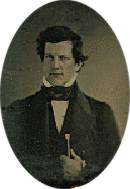Solomon Andrews (inventor)

Dr. Solomon Andrews (1806 – 1872)[1] was an aviator and dirigible airship inventor. Andrews invented an airship called Aereon which received some notice in the 1860s. He claimed to sail it as one would a sailboat.[2] Mention is made of the movement of pilot and passenger fore and aft in the basket to control attitude.[3] He was a medical doctor and three times Mayor of Perth Amboy, New Jersey. He constructed the city's first sewer system.
Biography
Dr. Solomon Andrews was born on February 15, 1806, in Herkimer, New York.[4] He received his medical degree from Rutgers Medical College, class of 1827.
He died on October 17, 1872, in Perth Amboy.[5]
Airships
His first "Aereon" flew over Perth Amboy on June 1, 1863. This had three 80-foot cigar-shaped balloons, with a rudder and gondola. Buoyancy was controlled by jettisoning sand ballast or releasing hydrogen lift gas.[2] Dr. Andrews wrote Abraham Lincoln later that summer offering the Aereon for use in the American Civil War, during which he served for a time as a volunteer surgeon in the Union Army.[5] After much discussion, he arranged a demonstration early in 1864 before the Smithsonian Institution. He was informed, nearly a year later, that the Government had little interest in his invention, and by that time the war was nearly over.

Andrews then organized the Aerial Navigation Company to build commercial Airships and establish a regular line between New York and Philadelphia.
The "Aereon #2" had one "lemon-shaped" balloon, sharply pointed at the ends. It controlled buoyancy with a system of lines and pulleys that compressed the gas or allowed it to expand.[2] This flew over New York City on May 25, 1866 and June 5, 1866. The second trip, carrying a passenger-assistant (a news reporter had to be left out at the last minute because of weight problems)[6] ended at Oyster Bay, Long Island. At this point, the post-war economic collapse and its bank failures destroyed the company, and he never flew again.
The difference of specific gravity between the balloon and the surrounding atmosphere could be converted by a system of inclined planes to steer the craft, without a motor.[7] He referred to his propulsion as "gravitation."[8] The craft was not normally trimmed to be neutrally buoyant. Instead it would be cycled between positive and negative buoyancy. The resulting airflow across the body of the craft and attached airfoils would propel it. (Picture a glider alternately rising and falling through the air.)
Other inventions
Andrews also invented a sewing machine, a barrel making machine, fumigators,[1] forging presses, a kitchen range, a gas lamp, a nicotine-filtering pipe, rekeying and a padlock which has been used by the U.S. Post Office since 1842.
Legacy
The Aereon Corporation attempted, in New Jersey in 1969, to replicate and improve on the airship designs of Solomon Andrews. This was written about in the book "The Deltoid Pumpkin Seed," by John McPhee (ISBN 9780374516352). This book and Andrews' work provided the inspiration for development of the Hyperblimp, and various embodiments of an underwater gliding toy, by inventor Daniel Geery.
Notes
- 1 2 Daniel Geery. 2007. hyperblimp history
- 1 2 3 pg. 20, Toland
- ↑ pg. 23, Toland
- ↑ Glazer, Stephen D. "Rutgers in the Civil War," Journal of the Rutgers University Libraries Vol. 66 (2014), page 102
- 1 2 Rutgers http://jrul.libraries.rutgers.edu/index.php/jrul/article/view/1865/3298
- ↑ pg. 22, Toland
- ↑ Solomon Andrews, The Art of Flying, 1865
- ↑ Toland, John (1972). The great dirigibles: their triumphs and disasters. Courier Dover Publications. p. 15. ISBN 0-486-21397-8. Retrieved 2010-01-12.
ISBN 9780486213972
(unabridged republication of the Holt edition 1957, titled Ships in the Sky: The Story of the Great Dirigibles)
External links
- Stevens Institute of Technology page on 1992 Pioneer inductees, Solomon Andrews (1806-1872)
- hyperblimp, Daniel Geery, 2007